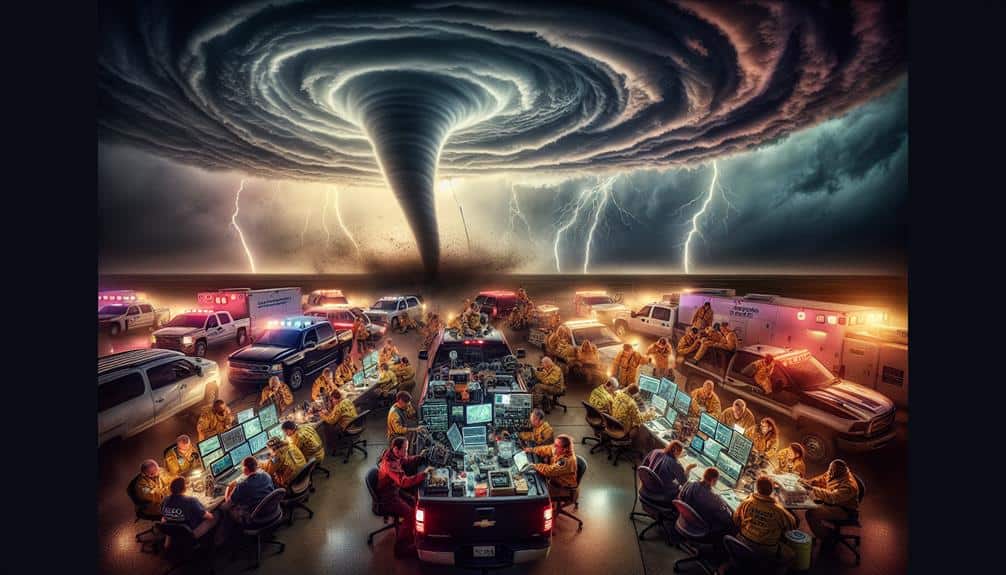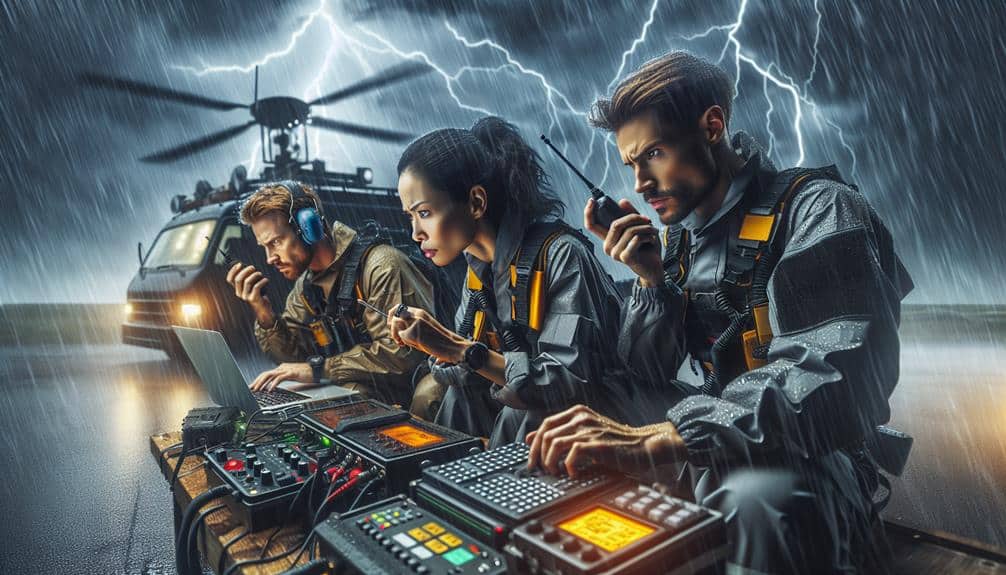Local authorities play a vital role in emergencies. We prepare through well-established plans, community training, and regular drills. Effective communication, including emergency alerts and social media updates, guarantees timely information. We allocate resources swiftly, manage public safety, and coordinate with agencies like the Red Cross and FEMA. By engaging communities and maintaining robust communication channels, we strengthen our collective response. In recovery phases, we focus on restoring stability, mental health support, and sustainable rebuilding. Interested in our coordination and the broader impact of our actions? Rest assured, you are in good hands.
Key Points
- Local authorities coordinate with agencies like FEMA and the Red Cross to ensure efficient resource allocation and emergency response.
- They maintain and update emergency preparedness plans, including evacuation procedures and communication systems.
- Local authorities engage and educate the community about emergency readiness, safety measures, and roles during crises.
- They facilitate real-time communication through emergency alert systems and social media to provide timely and accurate information.
Emergency Preparedness
Effective emergency readiness demands local authorities to have well-established plans and resources in place. As part of this, we must prioritize community involvement to guarantee everyone knows their role during a crisis. By engaging the community, we can build trust and encourage proactive behavior that enhances our collective safety.
Local authorities should implement thorough training programs tailored to different segments of the population, from first responders to ordinary citizens. These programs should cover crucial skills like first aid, evacuation procedures, and emergency communication. When we involve our community and equip them with the right knowledge, we empower them to act decisively during emergencies.
Moreover, regular drills and simulations are crucial. They help us identify gaps in our preparedness plans and offer opportunities for continuous improvement. By practicing these scenarios, we make sure that both authorities and community members are ready to respond efficiently.
In addition to training and involvement, local authorities need to maintain and update their emergency resources, such as shelters, medical supplies, and communication systems. Preparedness isn't a one-time effort; it requires ongoing attention to detail and a commitment to safeguarding our freedom and well-being.
Together, we can create resilient communities ready to face any emergency.
Real-Time Communication
In emergencies, our ability to communicate in real time is essential.
We must utilize emergency alert systems and social media updates to keep the public informed and safe.
These tools help us disseminate important information quickly and efficiently.
Emergency Alert Systems
Emergency alert systems play an important role in real-time communication during emergencies, guaranteeing timely information reaches the public. At the heart of these systems are robust communication protocols that local authorities establish well in advance. These protocols include predefined messages, designated alert channels, and clear escalation procedures. By adhering to these standards, we can swiftly disseminate vital information, helping to protect lives and property.
Community outreach is another key component. Local authorities don't just rely on technology; we actively engage with our communities to educate them about emergency alert systems. Through workshops, public meetings, and informational campaigns, we make sure that every resident understands how to receive alerts and what actions to take when they do. This proactive approach fosters a culture of preparedness and resilience.
Moreover, we prioritize inclusivity in our alert systems. Recognizing that not everyone has access to the same communication channels, we employ multiple methods—from text messages and phone calls to sirens and public announcements. This guarantees that all community members, regardless of their circumstances, receive essential updates in real time.
Social Media Updates
Social media platforms empower us to provide real-time updates and engage directly with the community during emergencies. In times of crisis, immediate and accurate information is crucial. By leveraging social media, we guarantee timely crisis communication, keeping everyone informed about evolving situations and necessary precautions.
Our real-time updates help dispel rumors and provide reliable information straight from the source. This transparency fosters trust and empowers individuals to make informed decisions.
Platforms like Twitter, Facebook, and Instagram allow us to reach a broad audience quickly, guaranteeing that essential information is accessible to all.
Community engagement is equally crucial. Through social media, we interact directly with residents, addressing their concerns and answering questions in real-time. This two-way communication strengthens our bond with the community and enhances overall safety.
People feel more connected and supported when they know they can reach out and receive prompt responses.
Resource Allocation

During emergencies, local authorities must swiftly allocate resources to guarantee the safety and well-being of the community. Effective funding distribution is indispensable. We secure that financial resources are directed to the most pivotal areas, supporting community needs and enhancing emergency response capabilities. By prioritizing funds, we can provide immediate relief and long-term recovery solutions.
Equipment deployment is another key aspect. From medical supplies to rescue tools, we must quickly distribute essential equipment to affected areas. This secures first responders have what they need to perform their duties efficiently. We're responsible for maintaining an inventory of emergency supplies and ensuring they're readily available when disaster strikes.
Volunteer management plays a crucial role in our resource allocation strategy. We coordinate with local volunteer groups, ensuring they're trained and ready to assist. Volunteers are often the backbone of emergency response, providing manpower and support where it's needed most. By organizing and deploying volunteers effectively, we can maximize their impact.
Public Safety Measures
In addition to resource allocation, we must implement strict public safety measures to protect our community during emergencies. By prioritizing community engagement, we ensure that everyone is informed and prepared. Effective communication channels, such as social media and local news outlets, allow us to quickly disseminate essential information. This transparency empowers individuals to take necessary precautions, thereby enhancing overall safety.
Our first responders play a pivotal role in this framework. They're the frontline heroes who act swiftly to mitigate risks and save lives. Equipping them with the right tools and training is necessary. We must guarantee they've access to the latest technology and resources to address any emergency efficiently.
Furthermore, public safety drills and educational workshops foster a culture of preparedness. By involving community members in these activities, we reinforce the importance of readiness and resilience. This active participation not only builds trust but also strengthens our collective response capabilities.
Ultimately, our goal is to create a secure environment where freedom and safety coexist. Through community engagement and robust support for our first responders, we can navigate emergencies with confidence and unity.
Collaboration With Agencies

When we collaborate with agencies, we guarantee a coordinated response that maximizes efficiency.
Our joint efforts streamline resource allocation, making it possible to address urgent needs swiftly.
Together, we can tackle emergencies more effectively and safeguard our communities.
Coordinated Response Efforts
Effective emergency response hinges on seamless collaboration between local authorities and various agencies. When disaster strikes, we must quickly activate our coordinated response efforts to guarantee the safety and well-being of our communities.
Local authorities play a pivotal role in community outreach, informing residents about the necessary steps to take during an emergency. This outreach is crucial for volunteer coordination, as it mobilizes community members to assist in various capacities, from first aid to logistical support.
Our responsibilities extend to shelter management and evacuation procedures, ensuring that displaced individuals have access to safe, temporary housing. By collaborating with agencies like the Red Cross and FEMA, we can provide essential resources and services more efficiently.
Effective evacuation procedures are critical; they require precise coordination with transportation authorities and first responders to safely move people out of harm's way.
Through these efforts, we aim to uphold the principles of freedom and self-reliance, empowering our communities to be resilient in the face of adversity. By working together, we can mitigate the impact of disasters and guarantee a swift, organized response that prioritizes the safety and freedom of our citizens.
Resource Allocation Strategies
To efficiently allocate resources during emergencies, we must collaborate closely with agencies like the Red Cross and FEMA. By doing so, we can guarantee our funding priorities align with the immediate needs of the community. Effective collaboration allows us to pool resources, share expertise, and streamline efforts to maximize community support.
Strategic planning is essential. We need to identify potential logistical challenges early on and develop contingency plans. This proactive approach helps us minimize delays and guarantee that aid reaches those in need without unnecessary hurdles. Working together with these agencies, we can map out clear roles and responsibilities, ensuring that all efforts are coordinated and efficient.
Funding priorities must be transparent and flexible. By clearly communicating how funds are allocated and ensuring they match the most pressing needs, we build trust within the community. It's also crucial to engage community members in the planning process, as their insights can highlight specific needs and potential solutions.
Post-Emergency Recovery
Local authorities play a central role in coordinating post-emergency recovery efforts to restore community stability. We focus on community engagement to make certain that every voice is heard and needs are met. By fostering open communication, we empower residents to actively participate in rebuilding their neighborhoods. This collective action not only speeds up recovery but also strengthens the bond among community members.
Equally important is providing mental health support. After a crisis, the psychological impact can be profound. We work with mental health professionals to offer counseling, support groups, and other resources to help individuals process their experiences and regain a sense of normalcy. Addressing mental health is vital for long-term recovery and resilience.
In addition to immediate relief, we plan for sustainable rebuilding. We assess the damage, allocate resources efficiently, and prioritize projects that will have lasting benefits. Infrastructure repairs, economic revitalization, and housing reconstruction are all tackled systematically to ensure a thorough recovery.
Frequently Asked Questions
How Do Local Authorities Prioritize Emergency Response Efforts?
We prioritize emergency response efforts through resource allocation and coordination, ensuring crucial services reach those in need. Clear communication and community engagement are essential to help everyone stay informed and involved, empowering our community during crises.
What Training Do Local Authorities Receive for Emergency Situations?
We're thrown into the fire with simulation exercises, sharpening our skills under pressure. We master crisis communication to guarantee clear, swift actions. This rigorous training empowers us, letting us protect our communities with precision and confidence.
How Can Citizens Contribute to Local Emergency Preparedness Plans?
We can contribute to local emergency preparedness plans through community involvement and joining volunteer programs. By working together, we guarantee our community's safety and resilience, empowering ourselves to respond effectively during emergencies. Let's get involved and make a difference.
What Technologies Do Local Authorities Use to Manage Emergencies?
Imagine a lifeline in chaos: we use advanced communication systems and Geographic Information Systems to map crises. Mobile applications keep us connected, while drones offer real-time surveillance. Together, these technologies guarantee efficient and swift emergency management.
How Do Local Authorities Handle Misinformation During Emergencies?
We manage misinformation by prioritizing crisis communication and community communication. We maintain public trust through transparent, accurate updates, and counter false info swiftly. Our misinformation management strategies uphold credibility and keep the community well-informed.


